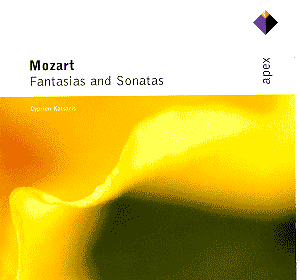Comparison recordings
Emile Naoumoff, Fantasias, Sonata #14, Rondo
in a - EMI 74927-2
Having previously admired Katsarisís recordings
of Liszt Symphonic transcriptions and Schumann Etudes, I approached
this disk with much favourable expectation and was not disappointed.
The playing is exemplary - clear, bright, and
with varied textures and rich drama. The instrument is a modern
grand piano, but there is neither any inappropriate expansion
of the tonality nor is there any obvious constriction of the range,
resulting in an authentic and natural sonority. Failure to understand
Mozartís humour, his mercurial sense of fun, even in his serious
works, is a frequent complaint I have against some Mozart interpreters,
present company fervently excepted. Katsaris allows, but does
not over-emphasise (as does Glenn Gould, for instance) Mozartís
little jokes against himself in the fantasia preludes where he
indulges in a little banging and measured banality, just to remind
you how lucky you are when he gets back to work.
The Sonata K457 is especially interesting in
the adagio where Mozart gives Beethoven the tune for his
Pathétique Sonata, and also invents quite a lot
of Liszt. The opening of the d minor fantasia K397 reminds one
of Beethovenís "Moonlight" sonata and of the first prelude
in Bachís Wohltemperierte Klavier, with which both Mozart
and Beethoven were thoroughly familiar, showing the genealogy
of the famous Beethoven work. Various movements on the disk contain
more of Beethovenís better ideas, in case there was any remaining
doubt as to where they came from.
Programming the two sonatas in reverse chronological
order on the disk points out how the early Mozart was more theatrical,
while the later sonata fits better among the fantasias.
The Fantasies are fascinating works in that they
show us what Mozartís improvisation style was like and give hints
to Mozart interpreters of how Mozart would have amplified his
published keyboard works when playing them himself. Only one,
K475, was completed and published. Kk396/7 were left to us in
the form of sketches and completed (skilfully!) by others. These
performances are among the very best Iíve heard, but I will continue
to enjoy the Naoumoff recording (which also includes an exceptional
performance of the Rondo in a, K511) for a slightly different
but equally valid viewpoint.
Paul Shoemaker
